MIDI in the Future Tense
COMPILED BY JIM PIERSON-PERRY
START CONTRIBUTING EDITOR
In the last four years, MIDI software for the ST has grown from a simple player piano emulator to sophisticated multitrack sequencers capable of real-time notation, equipment control and algorithmic composing. To give you the insider's perspective of MIDI trends for the rest of 1989 and beyond, we asked four of the most innovative MIDI software developers to describe their companies' latest products and their visions of the future of the ST MIDI market.
Tools of the Trade
by Al Hospers
Chief Executive Officer
Dr T's Music Software
I thought this article would be a piece I of cake; just whip off a list of things we are currently working on and the ideas kicking around in our collective heads. But the more I worked on it, the more complex it became, as I realized that we at Dr.T's had grown in an organic kind of way. Our vision right from the start was to create tools that would help us in our personal musical pursuits. We wanted to have a company, all right, but one which could fund development of these tools.
Our newest products include X-OR, a universal editor/librarian that is fully configurable to handle any MIDI-based equipment (instrument, F/X unit, lighting controller, etc.) and Tiger, an icon-oriented graphic editor that can run under our MPE or stand-alone. By the time you read this, these programs will have been out for a while.
What of the future . . . where are we going? I see our future in two areas. First will be extensions of our current tools. Examples are enhancements of Tunesmith to handle polyphony, adding more handles to the Programmable Variations Generator and Master Editor portions of KCS Level II, real-time transcription of sequences and playback by Copyist from within the MPE and a major update of our sequencer.
As a chief architect of the KCS, I have watched it grow as an evolving, almost living, entity of its own. We have taken it from its initial stages as a pure composition tool to a performance sequencer, then back to a highly advanced composition assistant. It's more evolutionary than revolutionary for us.
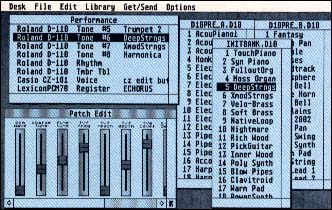 |
| X-OR from Dr. T is a universal editor/ librarian that can be config- ured to handle any MIDI-based equipment (instrument, F/X unit lighting, controller, etc.). |
Tools, T-Basic and Graphics
I'd like to think we are moving towards even more powerful tools--tools that have more and better functionality and that work together better (MIDI files and the MPE are steps down that road). These will not necessarily be as transparent as some pundits advocate. Emile Tobenfeld--Dr.T--and I are believers in the philosophy that the best tools are those created by designers with a strong sense of vision. Tools created thusly are never bland.
One of the newest modules for the MPE is T-Basic, a full implementation of the BASIC programming language that runs inside of the KCS. It has special extensions that give you control over most functions of the sequencer, as well as direct access to the MIDI data stored in the KCS. Anyone with a smattering of BASIC programming ability would be able to create applications rivaling commercial products in no time at all. You can create special-purpose functions to do almost anything you want. T-Basic takes our philosophy of giving users maximum flexibility to new limits. In this case they have almost total control; they are the programmers.
Emile recently created a new experimental program called the MIDI Axe, built on the foundation of our current Fingers program. It is a real-time performance program that runs in the MPE and lets you paint MIDI events on the computer screen. This is a program that leads in a direction that I think is very important: live interaction with other human players as well as the computer. In the right hands, this tool can be an amazing performance instrument.
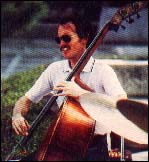 |
| Al Hospers, Chief Executive Officer, Dr. T's Music Soft- ware. |
Our second area for the future looks at movement towards the mass consumer marketplace. The professional music software market is a limited one. For example, we are all competing to sell high-quality (and high-priced) professional level sequencers to a select number of folks. The more general computer user--the closet-musician, so to speak--is where the next marketing opportunity lies. It's also where all the fun really is. These are the people are who can really use all of these computer-aided composition tools; the pros usually play their own stuff. I see a lot of promise in helping those people who want to play music but can't create something of their own.
There is also going to be an interaction between music and graphics in a big way. One possibility is some melding of the MIDI Axe and a paint program. Another might be something with a full sequencer built into it or running inside the MPE with access to all of the KCS functions. Of course, it would be mouse-controlled with meaningful icons and be synchronized to SMPTE, so you could use it to play along with a film score or another sequencer. It should build naturally on the familiar styles of current paint and draw programs so that users would be able to start creating immediately with it. I wish it existed already so I could use it now!
My hope for the future is that interactive music software will be around for a long time and that creative people ("true" musicians or not) find ways to use it and make interesting music. After all, the best reward for all this work is to see (and hear! ) the tools we create being used.
Everything is Under Total Control
by Chas Silvina
Regional Sales Director
Hybrid Arts, Inc.
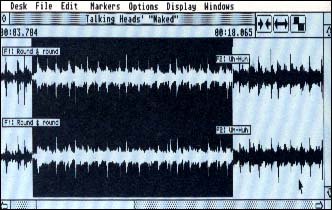 |
| If you want to make Max Headroom stutter, you can use DRE, Hy- brid Art's Digital Recorder Environment. DRE features in-and-out- point edit markers to set the range of a sample for playback. Re- peating a portion of a sample several times will produce the stut tering effect. |
Imagine a music program that can edit any MIDI synthesizer, past, present, or future. Then imagine this same program being able to edit and store presets of any MIDI-controlled signal processor. Combine these features with the ability to take a "snapshot" of your entire MIDI studio and store the information for instant recall at any time; and don't forget the real-time MIDI mixing of all of your MIDI instruments. All these features and more will be available in GenEdit--the forthcoming editing/ control program from Hybrid Arts.
This is just one example from the new generation of professional MIDI products we will release in the coming months. Following on the heels of the long-awaited Official Release Version of our "industry-standard" SMPTE-Track sequencer and Total Control systems, we have launched a program to develop user-friendly real-time interfaces for all of our new products. Some of these features will be added to existing programs such as our MIDI-Track line of sequencers.
We feel that the most dramatic of these new programs is our cyclic recording feature with multi-level/multi-take spot and in-place editing, along with a vastly redesigned graphic user interface. This new addition is optimized for drum or melodic instrument recording and allows indefinite levels and takes of cycles. You can store and edit them for easy instant recall, all in real-time.
ADAP II
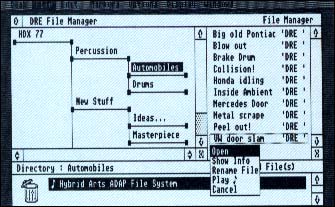 |
| The new File Manager that comes with ADAP II can provide excel- lent file management for professionals who have to access a large number of sound samples. It's akin to a new desktop for sound ef- fects but can only be accessed through ADAP II. |
This April saw the release of our digital audio system, ADAP II. This system has been designed as an open-ended system for digital audio mastering and pre/post-production audio for motion pictures and television, as well as being a powerful MIDI performance instrument in its own right. ADAP II offers a new, complete, and unique MIDI performance page with many features, including eight-voice polyphony at 44.1 kHz (12- to 16-voice polyphony at lower sample rates), LFOs for pitch and volume modulation and an ADSR graphic interface for pitch and volume control. A new key map editor lets you set individual amplitudes for each key with full MIDI controller implementation and full multi-timbral capability. Its most striking feature may be the ability it gives to instantly edit and play back sounds not only from the RAM-based editor but from any recorded direct-to-hard-disk file.
Hybrid Arts has dedicated itself to continue development of new and innovative products that will aid the musician with facile real-time interfaces. As our users' needs change, we will provide products to meet them.
The Personal Touch
A round-table discussion with Intelligent Music's Eric Ameres, author of M and RealTime, Mark Brown, author of Cartographer, and Richard Lainhart, I.M.'s Technical Director.
Multi-Tasking is the Wave of the Future
Eric: The future of music on the Atari ST is a true multi-tasking OS [Operating System]. If a good, reliable GEM-based multi-tasking operating system came out, that would be great. MIDI, in particular, needs a way of multi-tasking because what you want to do is have a number of applications up and running at the same time. This would let you access the power and features of any number of MIDI programs without having to stop what you're doing to jump between them. If you are doing SMPTE synchronization in one program, you can do a sequence in another and graphic animation somewhere else. You've got to have some way of locking them all together. The idea would be to have some main timer that multiple programs could access.
Mark: Besides having a common time reference, there must be a standard way for several MIDI applications, regardless of their parent company, to share the Atari MIDI input and output ports. Some developers have come up with their own unique ways of handling this problem. We would like to see a standard way to do this.
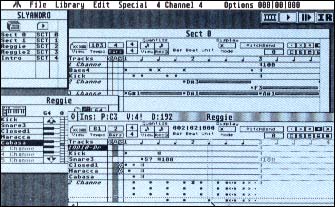 |
| RealTime from Intelligent Music lets you record and play musical ideas--so you can manipulate them in real-time. The program will provide variations on your sequences as you compose them. |
Eric: We're eager to take part in developing a multi-tasking operating system or an enhancement to the Atari OS. Maybe it could be developed jointly with other companies, so that it would support the kinds of improvements we'd all like to see. This standard should be readily available to everyone.
Mark: In the meantime, we're going to be exploring the multi-tasking possibilities within Intelligent Music programs. We're going toward a system in which programs not only run at the same time but also work together.
Richard: . . . and still provide some access to programs from other companies. It would be a shame to be in competition with other companies when we could be working together.
A Need for Standardization with the ST.
Eric: The future of MIDI on the ST has to be linked to an organized standard from Atari for developers. Right now, the closest thing towards an honest-to-God standard is MIDI Files. With MIDI Files, something created in M can be brought into RealTime and then bumped into Notator to print out a score.
Mark: With the possible changes in MIDI that the IMA/MMA [MIDI standardization committees] is considering, Atari should support the new MIDI hardware themselves. Otherwise, we'll see developers all designing their own hardware again--like the different MIDI expansion products we have now. Atari should come up with a standard box that would plug into the cartridge port to support the existing MIDI standard and any new MIDI hardware requirements. Developers would be happy because there would be one standard. No more duplication of effort.
Performance Software and MIDI
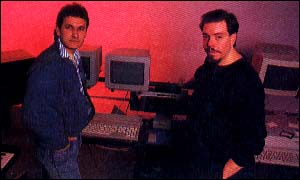 |
| Intelligent Music's Eric Ameres, author of M and RealTime, and Richard Lainhart, Intelligent Music's Technical Director |
Eric: MIDI software should not re-invent the past. There is no sense making your Atari into a tape recorder. A tape recorder-type sequencer is a limited tool for a composer or performer. MIDI was designed because someone wanted to press one key and have six things happen. We are starting to see programs that offer new angles on the music-making process.
Richard: . . . such as M, for composers. It's a different way of thinking about music, a different way of approaching the interaction between the composer and the computer.
Eric: Everyone's focused on editing right now. Programs like M, MidiDraw and RealTime are not about editing but more about spontaneous manipulation and editing on a global level. There's a point after which you're actually composing rather than tweaking notes.
Richard: Our programs are particularly geared for performance. That's the big idea behind the company itself. Five years ago you'd never see people using the computer in performance. Now, computers are more powerful than dedicated hardware sequencers will ever be. Using a traditional sequencer means everything is going to be exactly the same every time. Real performance is about making music on the spot, not making it a few weeks ago and playing it back. M is designed to involve the computer in spontaneous performance. Using Cartographer as a performance processor, you can control entire banks of synthesizers and have hundreds of devices respond to your will. That's power! That's what the computer is all about--extending your power over your instruments.
Mark: Sequencers are into features, but no one has addressed the problem of managing your gear. It's been a big barrier to people who are learning a new sequencer. RealTime and Cartographer clear all that up.
Eric: . . . programs that know about your particular instrument setups, so you can tailor them to the way you work with your system.
Richard: We have a pretty strong product line for the Atari right now. Our products are strong because they are programs and tools that can be used in any professional environment, and they all can work with programs from other companies.
Eric: The machine can support professional products. The big hurdle that Atari faces is developing people's attitude about the computer itself. The ST is not a game machine (at least not exclusively--we all enjoy a good game of Dungeon Master once in a while!).
Multi Tasking for Musicians
by Geoff Ryle
Product Specialist
Steinberg/Jones
Steinberg produced the first professional ST sequencing program, the PRO-24, and has since followed through with more than 18 MIDI programs for the ST. Our success is largely due to Steinberg's respect of the user as an integral part of the program development process. What's next? How about the first multi-tasking operating system for the ST specifically designed for musical applications?
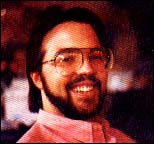 |
| Geoff Ryle, Product Specialist, Steinberg/ Jones. |
M. ROS (MIDI Realtime Operating System) is the most recent breakthrough from Steinberg. Over two years in the making, it delivers true multitasking and lets you control several programs simultaneously on one computer. For example, working on a song with your sequencer, you could immediately move to a patch editor program--while the sequencer is still playing or recording. You could also add an automated mixing program, synchronized to your sequencer, recording all your mix movements. Previously, a separate computer had to be dedicated to each individual application.
M.ROS consists of three major components: a Message Manager, MIDI Manager and Timing Manager. The Message Manager oversees communications between concurrent programs. The MIDI Manager handles traffic going in and out of the various MIDI ports, directing the MIDI messages to their intended programs. Either of two hardware options can be used to give up to six independently addressable MIDI Out ports. Finally, the Timing Manager handles synchronization of the various resident programs.
Timing control in M.ROS is bedrock stable due to an intelligent priority system which produces extremely accurate timing. Multiple tasks are handled efficiently, even if they involve large quantities of MIDI data. This accuracy becomes most evident when using multiple MIDI outputs, virtually eliminating MIDI delays. Two timing dimensions are supported: one for SMPTE related programs (cue-sheet type) and one for musical applications (sequencers).
The system may be synchronized to several sources: SMPTE, MTC (MIDI-Time-Code), MIDI-Clock with Song-Position Pointer and a "Human" Clock. This last option uses highly accurate interpolation algorithms that let you control tempo remotely from a MIDI trigger (keyboard note or a drum sensor). The entire system is synchronized with an accuracy of 1 SMPTE sub-frame (e.g. 0.5 milliseconds at 25 frames per second) and a musical resolution of 384 pulses per quarter-note (ppq).
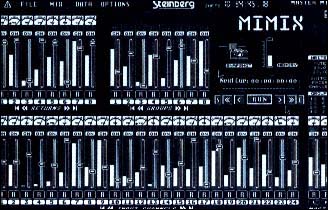 |
| MIMIX from Steinberg/Jones is an automated mixing software/- hardware package that provides up to 64 channels of automation and can be installed into virtually any mixing console. |
Other New Programs
New programs are already beginning to appear which build on M.ROS, including CUBIT, Steinberg's newest generation of sequencers. CUBIT provides 16 X 64 tracks, real-time editing, and four independent graphic edit pages. Various innovative quantize modes are supported including "Groove" Quantize, through which the user can create and store an individualized rhythmic style and use it to quantize any track. Intelligent window management allows several different windows to be open simultaneously. There are 16 Arrange windows, with 64 tracks in each; other windows include: Key-Edit, Score-Edit, Grid-Edit and Drum-Edit.
An ideal partner to CUBIT is MIMIX, Steinberg's automated mixing software/hardware package. MIMIX provides up to 64 channels of automation and can be installed into virtually any mixing console. It will even read your faders, converting fader movements to MIDI data. M.ROS synchronizes MIMIX with CUBIT, allowing you to locate and playback/record from any position in your song--from within either program.
Another new product is AVALON, a generic sampler editor that can be configured to work with most popular samplers. Operating within M.ROS lets you execute multiple applications, such as starting a MIDI sample-dump to your sampler and recording a song into a sequencer while waiting for the dump to finish.
Several computers can be networked together under M.ROS with control of the entire system directed from one master computer. M.ROS manages all communications and synchronization between the various programs and computers. Presently available for the Atari ST, M.ROS is scheduled to be available for Apple Macintosh and IBM PC computers before the end of the year. Imagine, each musician in a group can have his or her own work-station.
ST/MIDI users have been waiting a long time for something like M.ROS to come along. Now it's here, and Steinberg plans to take it even further. With all its present power and focus on musical applications, M.ROS will continue to evolve and improve--assisted by the help of user feedback. New developments and applications are constantly in the works. At this time, only a portion of its full potential has been realized.
START Contributing Editor Jim Pierson-Perry is a research chemist and semi-professional musician living in Elkton, Maryland.
FOR FURTHER INFORMATION, CONTACT
Dr. T's Music Software, 220 Boylston Strod, Suite 306, Chestnut Hill, MA 02167, (617) 244-6954.
Hybrid Arts, Inc., 11920 West Olympic Blvd., Los Angeles, CA 90064, (213) 826-3777.
Intelligent Music Computer Systems, Inc., P.O. Box 8748, Albany, NY 12208 (518) 434-4110.
Steinberg/Jones, 17700 Raymer Street, Suite 1001, Northridge CA 91325 (818) 993-4091.